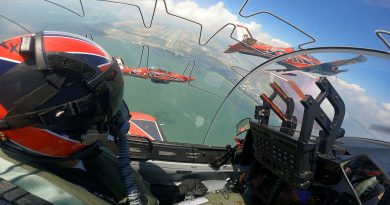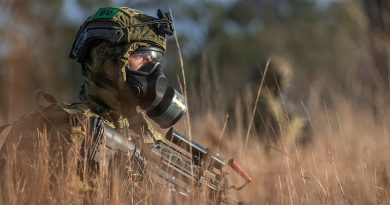RAAF chefs serve up hot shots

Royal Australian Air Force chefs are taking training out of the frying pan and into the firing range, attending bi-weekly weapons sessions to beef up their combat preparedness at RAAF Base Amberley.
CAPTION: Leading Aircraftman Henry Lam, centre, uses the weapons training simulation system at RAAF Base Amberley, Queensland. Story by Corporal Michael Rogers. Photos by Leading Aircraftman Campbell Latch.
When 23 Squadron catering officer Flying Officer Dale Shepherd surveyed his chefs to see what could make their jobs more appealing, a lack of military training was a common thread.
Flying Officer Shepherd developed a force generation training program to implement a two-hour session every Tuesday and Thursday for chefs to go to the Weapon Training Simulation System (WTSS) to conduct combat shooting.
Initially there was hesitation from chefs who saw it as another task added to an already busy schedule, but the program’s uptake has been exceptional.
To ensure availability for the sessions, breakfast on training days has changed to an extended continental menu, which requires fewer chefs to manage.
Leading Aircraftwoman Chantel Munro started training from the first session, because whenever her weapon proficiency test would come around, she had to relearn handling and shooting drills.
CAPTION: Sergeant Samuel Trew, of 23 Squadron, conducts a safety briefing with Royal Australian Air Force chefs at the WTSS at RAAF Base Amberley.
“Our instructor, Sergeant Trew, has been fabulous, running through the weapons handling test to enforce correct procedure and teaching us extra skills that I suppose we weren’t really taught,” Leading Aircraftwoman Munro said.
“I feel much more confident with handling the weapon and the drills now.
“Getting to shoot alongside our chain of command as well has really helped communication between leadership and us.”
For Leading Aircraftman Jack Wright, the sessions he has attended have been the highlight of his year.
“I come from a cheffing background, so I’m very passionate about it, but it can get pretty monotonous,” Leading Aircraftman Wright said.
“The weapon training definitely adds to the military aspect of my job, taking it away from feeling like a regular nine-to-five, and I’ve definitely seen improvements in my ability.”
Flying Officer Shepherd issued an ongoing challenge to his chefs – a can of soft drink on the boss for whoever can out-shoot him during a session.
So far only one person has claimed the prize – Warrant Officer Kyle Mitchell – but others are catching up fast.
The first time the section attempted Range Practice 3A, only about 20 per cent hit the 130-point pass mark.
After three weeks of practice, nearly 60 per cent of participants were shooting over 130 points consistently.
Continuation of the force generation is important, according to Flying Officer Shepherd, who plans to ramp up the training to include more advanced range practices and physical conditioning.
“It gives me confidence that the training is working and, though some people are only going once a month, some really high performers are going to every single session,” Flying Officer Shepherd said.
“The future goal of one high performer is to respec into combat controller, so I’m hoping this participation will help his future application.”
Taking part in the training has not only built confidence with weapons, but also in participants’ day-to-day kitchen life, according to Leading Aircraftwoman Munro.
“It definitely gives you more confidence in what you’re capable of, but it also gives me more confidence in my workmates,” she said.
“You know that if you are ever in that kind of situation, you can trust they will be able to handle themselves.”
The above report originally contained zero references to “Royal Australian” or RAAF – an ‘error’ corrected by CONTACT. See here why we think this matters.
.
.

.
.






